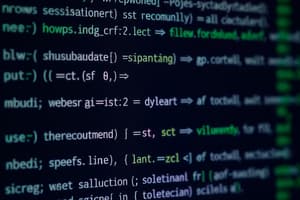Podcast
Questions and Answers
What action does the assignment statement x = 1 instruct Python to perform?
What action does the assignment statement x = 1 instruct Python to perform?
- Calculate the square root of 1 and store it in x.
- Store the value 1 in a memory location named x. (correct)
- Print the value of x.
- Check if the value of x is equal to 1.
In programming, the equal sign in an assignment statement functions identically to its use in mathematical equations.
In programming, the equal sign in an assignment statement functions identically to its use in mathematical equations.
False (B)
What is the primary purpose of reserved words in a programming language like Python?
What is the primary purpose of reserved words in a programming language like Python?
To define specific actions or commands that the language understands.
A Python program saved in a file is commonly referred to as a ______ and has the file extension .py.
A Python program saved in a file is commonly referred to as a ______ and has the file extension .py.
Match the programming concept with its description:
Match the programming concept with its description:
What happens when Python encounters a syntax error?
What happens when Python encounters a syntax error?
It is generally more efficient to write entire Python programs interactively in the Python interpreter rather than using a script.
It is generally more efficient to write entire Python programs interactively in the Python interpreter rather than using a script.
What is the role of indentation in Python code, especially within conditional (if) or loop (while, for) statements?
What is the role of indentation in Python code, especially within conditional (if) or loop (while, for) statements?
The if statement in Python is an example of a ______ step, which allows a program to execute different code based on a condition.
The if statement in Python is an example of a ______ step, which allows a program to execute different code based on a condition.
Match the following terms with their description:
Match the following terms with their description:
In the context of loops, what is an iteration variable?
In the context of loops, what is an iteration variable?
An infinite loop is intentionally designed to run without stopping.
An infinite loop is intentionally designed to run without stopping.
Explain the difference between the while and if statements in terms of how they control the flow of execution in a program.
Explain the difference between the while and if statements in terms of how they control the flow of execution in a program.
In the discussion about counting the most common word in a file, creating a ______ was mentioned as a way to map words to their frequencies.
In the discussion about counting the most common word in a file, creating a ______ was mentioned as a way to map words to their frequencies.
Match the term with its corresponding definition in programming context:
Match the term with its corresponding definition in programming context:
What is the purpose of the print function in Python?
What is the purpose of the print function in Python?
A for loop and a while loop can always be used interchangeably in Python.
A for loop and a while loop can always be used interchangeably in Python.
Explain what the term 'nesting' refers to in the context of loops and conditional statements.
Explain what the term 'nesting' refers to in the context of loops and conditional statements.
In a conditional statement, the code that is executed only when the condition is true is typically placed in an ______ block.
In a conditional statement, the code that is executed only when the condition is true is typically placed in an ______ block.
Match the following editors with their features:
Match the following editors with their features:
Which of the following describes the flow of execution in a sequential program?
Which of the following describes the flow of execution in a sequential program?
In Python, variables must be declared with a specific data type (e.g., integer, string) before they can be used.
In Python, variables must be declared with a specific data type (e.g., integer, string) before they can be used.
What is the significance of the colon (:) at the end of an if, for, or while statement in Python?
What is the significance of the colon (:) at the end of an if, for, or while statement in Python?
To ensure that a loop eventually terminates, it is important to include an ______ that modifies a variable used in the loop's condition.
To ensure that a loop eventually terminates, it is important to include an ______ that modifies a variable used in the loop's condition.
Match each editor with its description:
Match each editor with its description:
What is the primary function of a Python script?
What is the primary function of a Python script?
Reserved words can be used freely as variable names in Python programs.
Reserved words can be used freely as variable names in Python programs.
Explain why indentation is considered important in Python.
Explain why indentation is considered important in Python.
The term 'DRY' in programming stands for 'Don't ______ Yourself'.
The term 'DRY' in programming stands for 'Don't ______ Yourself'.
Match the file extensions types with respective languages:
Match the file extensions types with respective languages:
Which symbol is commonly used for single-line comments in python?
Which symbol is commonly used for single-line comments in python?
Python is a compiled language.
Python is a compiled language.
What's difference between tuple and list in Python?
What's difference between tuple and list in Python?
A collection of key-value pair is otherwise known as ______.
A collection of key-value pair is otherwise known as ______.
Connect the different functions with return types:
Connect the different functions with return types:
What does // do?
What does // do?
Python supports multiple inheritance.
Python supports multiple inheritance.
What is a lambda function in the context of programming?
What is a lambda function in the context of programming?
Python code is saved as ______ files.
Python code is saved as ______ files.
Join the library functions with relative descriptions:
Join the library functions with relative descriptions:
What is the primary function of an assignment statement in Python?
What is the primary function of an assignment statement in Python?
Reserved words in Python can be used as variable names.
Reserved words in Python can be used as variable names.
What is the file extension typically used for Python script files?
What is the file extension typically used for Python script files?
The ____ statement is a reserved word in Python used to create a loop that executes as long as a condition is true.
The ____ statement is a reserved word in Python used to create a loop that executes as long as a condition is true.
Match the following Python code structures with their description.
Match the following Python code structures with their description.
Flashcards
Interactive Python
Interactive Python
A command-line tool that allows users to interact with the Python interpreter by typing and executing code line by line.
Assignment Statement
Assignment Statement
A statement that assigns a value to a variable, creating a named storage location in the computer's memory.
Print Statement
Print Statement
A keyword that instructs Python to display the value of a variable or expression on the screen.
Syntax
Syntax
Signup and view all the flashcards
Reserved Words
Reserved Words
Signup and view all the flashcards
Line (in programming)
Line (in programming)
Signup and view all the flashcards
Variable
Variable
Signup and view all the flashcards
Operator
Operator
Signup and view all the flashcards
Function
Function
Signup and view all the flashcards
Parameter
Parameter
Signup and view all the flashcards
Script
Script
Signup and view all the flashcards
Sequential Execution
Sequential Execution
Signup and view all the flashcards
Conditional Execution
Conditional Execution
Signup and view all the flashcards
If Statement
If Statement
Signup and view all the flashcards
Looping
Looping
Signup and view all the flashcards
While and For loops
While and For loops
Signup and view all the flashcards
Nesting
Nesting
Signup and view all the flashcards
Iteration Variable
Iteration Variable
Signup and view all the flashcards
Infinite Loop
Infinite Loop
Signup and view all the flashcards
Study Notes
- Python can be used interactively through a command line interface accessed by typing "python".
- Python interprets commands that are typed and waits for instructions.
Assignment Statements
- Assignment statements in Python use the equal sign (=) to assign a value to a variable
- Python takes a piece of computer memory, names it with the variable, and stores the value in that memory location.
x = 1means the value1is stored in memory and namedx.
Print Statements
print(x)retrieves the value stored in the memory locationxand displays it.- Expressions like
x = x + 1will take the current value ofx, add1to it, and then store the new value back intox. - Errors in the typed statements will lead to syntax errors.
Python Vocabulary
- Reserved words have specific meanings in Python and cannot be used as variable names.
- Examples include
import,assert,if,for,pass, andwhile. - Reserved words like
walkare understood by dogs in the same way that Python recognizes reserved words.
Python Sentences
- Sentences are lines of code in a Python program
- Paragraphs are constructed from a series of these lines.
Operators, Functions, and Parameters
- Operators such as
+and=are used to perform operations printis a function that takes a parameter (e.g.,x) to output its value.
Python Programs
- Interactive Python is useful for learning, but for larger programs, code is typically written in a text file.
- Python files typically have a
.pyextension. - Text editors like Atom can syntax highlight
.pyfiles, which helps in understanding the code and identifying syntax errors. - Scripts are stored sets of instructions in text files that Python can execute.
Basic Patterns
- Sequential execution involves performing one step after another in order.
- Conditional execution involves executing a block of code only if a certain condition is true
- Repetition involves repeating a series of steps multiple times.
- The fourth pattern, store and retrieve, is introduced in Chapter 4.
Sequential Steps
- Code executes line by line in the order it appears in the script.
- Example:
x = 2print(x)(output: 2)x = x + 2print(x)(output: 4)
Conditional Steps
- Conditional execution is controlled by
ifstatements. - If the condition in the
ifstatement is true, the indented block of code is executed; otherwise, it is skipped. - Example:
x = 5if x < 10:
print('Smaller')if x > 20:
print('Bigger')print('Finish')
- Output:
Smaller,Finishsince the firstifcondition is true and the second is false.
Repeated Steps (Loops)
- Loops are used to repeat a block of code multiple times.
- Two main types of loops:
whileandfor. - A
whileloop continues executing as long as a certain condition is true. - Example:
n = 5while n > 0:
print(n)
n = n - 1print('Blastoff')
- Loops must have a mechanism to terminate to avoid infinite loops.
- Iteration variables are used to control the number of times a loop executes
Combining Patterns
- Programs often combine sequential, conditional, and repeated steps.
- Shows an example word-counting program that uses all three patterns.
- The program reads a file, creates a histogram of word frequencies, and finds the most frequent word.
Program Structure
- Top part of the example program reads a filename from the user and opens the file.
- Middle section creates a histogram, counting word frequencies.
- Final part goes through the histogram to locate the word that occurs most often
Course Progression
- Concepts will become clearer around Chapters 6 and 7.
- Chapter 1 provides an overview of the course and introduces basic vocabulary related to hardware and programming concepts.
Studying That Suits You
Use AI to generate personalized quizzes and flashcards to suit your learning preferences.




